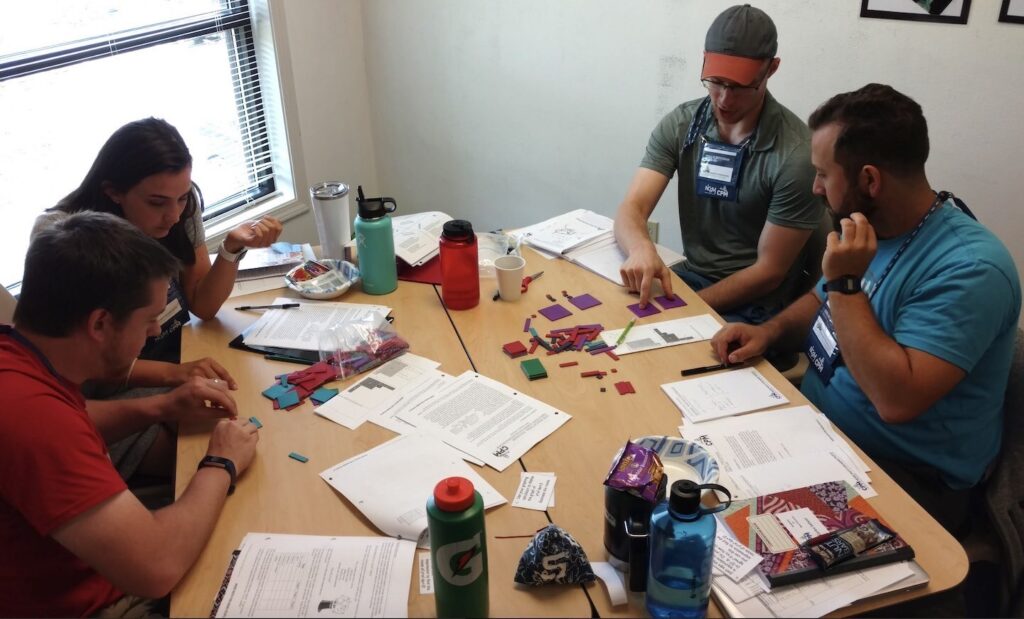
Submission Deadline: June 1 at 11:59 pm PST
Award Duration: 1-2 Years
Number of Awards Available: 1
Submission:
Applications should be submitted in pdf form by the deadline using the “Submit a Proposal” button at the top of this page. Late proposals will not be accepted. Please send questions to research@cpm.org
Decision Announced: October
Funding Cap: $50,000
CPM Educational Program (“CPM”, https://cpm.org/who-are-we) is a California nonprofit 501(c)(3) corporation dedicated to improving grades 6-12 mathematics curriculum and instruction. Therefore, one of the goals of CPM is to support research on problem-based mathematics learning, as well as on the strengths and limitations of particular designs for professional learning around instruction aimed towards such learning. To this end, CPM offers award opportunities to fund educational research that will contribute to the understanding of how to improve mathematics teaching and learning in grades 6-12 in the United States. These awards support research that build theory, develop methodological tools, and establish knowledge around four key features of secondary mathematics education: curricular materials, teaching, learning, and/or professional learning.
CPM wishes to fund research that serves the wider mathematics education community by leading to the development of theory and the improvement of practice. CPM encourages research proposals that consider important educational questions that can inform mathematics education in areas such as curriculum design, teacher education and professional learning, and ecological features that support teacher or student learning. All funded research proposals will (a) be consistent with the mission and support the vision of CPM, (b) offer insight into ways to improve mathematics teaching and learning at the secondary level, and (c) demonstrate the potential to lead to publishable results to support the broader mathematics education research field. Examples of topics relevant to this call for proposals include but are not limited to:
Research questions do not need to focus centrally on CPM or be solely about CPM, but all proposals should make clear how CPM materials or professional learning are involved and a good fit for the project’s goals. Research about textbook content alone can focus on student or teacher versions of curriculum and should involve the most recent version of textbook materials.
All proposed project must include at least one deliverable that supports the practice of mathematics education. Examples include but are not limited to frameworks for curriculum design, teacher observation tools, surveys, and design principles for professional learning workshops. CPM will have the right to use deliverables to support the teachers and students who use CPM materials and professional learning
Because of the paucity of video available from collaborative, problem-based mathematics classrooms at middle- and high-school levels, studies that can increase the number of video cases usable in teacher education and professional learning are highly encouraged, not required.
Research proposals to evaluate curricula will not be considered. For example, a research question such as, Do students persevere more in problem solving in CPM classrooms compared to other classrooms?, will not be considered for funding as such questions are not designed to produce findings useful for improving mathematics education outside of CPM contexts.
Proposals that evidence or are likely to propagate a deficit perspective of teachers will not be considered for funding.
Proposed research must come from institutions or organizations (not individuals) supporting educational research in the United States, have a single Principal Investigator (PI) with a doctorate in mathematics education or in an equivalent field, and can have up to two co-PIs. The institution(s) or organizations can contract with other institutions (for example, if one of the co-PIs works at a different institution). CPM will communicate with and fund the primary institution as the institute responsible for the study.
All PIs and co-PIs on projects funded by CPM must be certified for research on human subjects, and, if awarded funding, receive and furnish evidence for IRB approval prior to starting the research.
A budget table and budget justification are required. Budgeted expenses must be clearly linked to research goals, including course buyout information (must be warranted by study design), participant honorariums (note that CPM expects the time and participation of any teachers to be respected and compensated appropriately), and any relevant and necessary equipment or supplies.
CPM textbook materials can be included in the proposed budget as needed, or an eBook license can be provided free of charge for awardees. Proposal authors who are not yet familiar with CPM are strongly encouraged to contact research@cpm.org to access relevant information regarding CPM curricular materials, professional learning, coaching, and/or classroom implementation.
The budget must include funding for travel to and from the annual CPM Teacher Conference (held in California, typically in February) for at least the Primary Investigator in order to present emerging findings in a manner appropriate for a teacher audience. This travel will occur the year following the grant’s conclusion.
Eligible expenses for travel to conferences (beyond the CPM annual conference) are limited to research conferences at which the proposed research results are presented. The total travel budget (beyond the CPM annual conference) is limited to $2000 per year.
As a nonprofit organization, CPM is governed by its Board of Directors and can only accept budgets that include a maximum of 10% in indirect costs. Budgetary limits are inclusive of indirect costs.
Budgets must include line items for projected equipment purchases.
The following template must be used for the budget: CPM Grants Budget Template.
In addition, proposals must include the following elements (beyond the narrative page limit):
Proposals will be reviewed by a series of sub-committees composed of established and early career scholars employed by universities rather than CPM, as well as CPM teacher leaders or other CPM employees whose daily work is closely tied to the practical work of teaching. The review process is rigorous and attends to each of the above areas in detail, including how each section supports the overall goal of the proposed research and the ways in which the proposed research will contribute to existing research. Please be sure to attend to each area carefully so as to construct a coherent proposal, while also attending to page limits and feasibility of research within the timeline and budget. Review categories include:

This professional learning is designed for teachers as they begin their implementation of CPM. This series contains multiple components and is grounded in multiple active experiences delivered over the first year. This learning experience will encourage teachers to adjust their instructional practices, expand their content knowledge, and challenge their beliefs about teaching and learning. Teachers and leaders will gain first-hand experience with CPM with emphasis on what they will be teaching. Throughout this series educators will experience the mathematics, consider instructional practices, and learn about the classroom environment necessary for a successful implementation of CPM curriculum resources.
Page 2 of the Professional Learning Progression (PDF) describes all of the components of this learning event and the additional support available. Teachers new to a course, but have previously attended Foundations for Implementation, can choose to engage in the course Content Modules in the Professional Learning Portal rather than attending the entire series of learning events again.
The Building on Instructional Practice Series consists of three different events – Building on Discourse, Building on Assessment, Building on Equity – that are designed for teachers with a minimum of one year of experience teaching with CPM instructional materials and who have completed the Foundations for Implementation Series.
In Building on Equity, participants will learn how to include equitable practices in their classroom and support traditionally underserved students in becoming leaders of their own learning. Essential questions include: How do I shift dependent learners into independent learners? How does my own math identity and cultural background impact my classroom? The focus of day one is equitable classroom culture. Participants will reflect on how their math identity and mindsets impact student learning. They will begin working on a plan for Chapter 1 that creates an equitable classroom culture. The focus of day two and three is implementing equitable tasks. Participants will develop their use of the 5 Practices for Orchestrating Meaningful Mathematical Discussions and curate strategies for supporting all students in becoming leaders of their own learning. Participants will use an equity lens to reflect on and revise their Chapter 1 lesson plans.
In Building on Assessment, participants will apply assessment research and develop methods to provide feedback to students and inform equitable assessment decisions. On day one, participants will align assessment practices with learning progressions and the principle of mastery over time as well as write assessment items. During day two, participants will develop rubrics, explore alternate types of assessment, and plan for implementation that supports student ownership. On the third day, participants will develop strategies to monitor progress and provide evidence of proficiency with identified mathematics content and practices. Participants will develop assessment action plans that will encourage continued collaboration within their learning community.
In Building on Discourse, participants will improve their ability to facilitate meaningful mathematical discourse. This learning experience will encourage participants to adjust their instructional practices in the areas of sharing math authority, developing independent learners, and the creation of equitable classroom environments. Participants will plan for student learning by using teaching practices such as posing purposeful questioning, supporting productive struggle, and facilitating meaningful mathematical discourse. In doing so, participants learn to support students collaboratively engaged with rich tasks with all elements of the Effective Mathematics Teaching Practices incorporated through intentional and reflective planning.